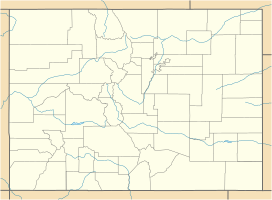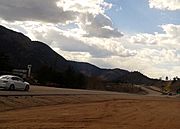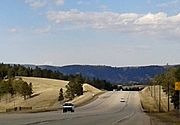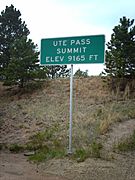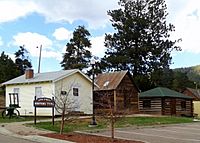Ute Pass facts for kids
The Ute Pass is a famous mountain pass located west of Colorado Springs, Colorado. It stretches from a high point of 9,165 feet (2,793 meters) at Divide down to 6,165 feet (1,879 meters) at its lowest part. This historic pass has been an important route for centuries.
Quick facts for kids Ute Pass |
|
|---|---|
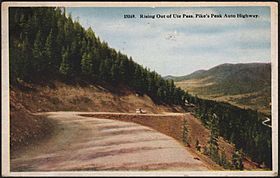
Rising out of Ute Pass. Pike's Peak Auto Highway (Colorado), 1924.
|
|
| Elevation | 9,165 ft (2,793 m) |
| Traversed by | |
| Location | Teller County, Colorado United States |
| Range | Front Range |
| Coordinates | 38°56′30″N 105°09′25″W / 38.94167°N 105.15694°W |
| Topo map | USGS Divide |
Contents
How Ute Pass Was Formed
About 75,000 years ago, huge sheets of ice called glaciers moved down the sides of what is now Pikes Peak. At the same time, the ground slowly pushed upward.
This combination of moving tectonic plates (large pieces of Earth's crust) and the powerful force of moving boulders created the steep canyons you see at the entrance of Ute Pass.
From the entrance at Manitou Springs, the road goes through steep canyons for about 5 miles. It has many curves. After that, the land becomes less steep. It eventually turns into gentle, U-shaped valleys near the highest point at Divide.
Where is Ute Pass Located?
Ute Pass is found west of Colorado Springs. It is just north of Pikes Peak. The pass follows U.S. Highway 24.
As you travel from west to east, the pass goes through several towns. These include Divide, Woodland Park, Green Mountain Falls, Chipita Park, and Cascade.
Water from the mountains in Ute Pass flows into Fountain Creek. This creek then runs through a canyon west of Manitou Springs.
History of Ute Pass
The Ute Trail runs along the north side of Pikes Peak. People believe it was first a buffalo trail. Buffalo used it to travel from the warmer eastern plains in winter to the green meadows of South Park, Colorado in summer.
In 1847, Joel Palmer wrote about these trails in his journal. He said they were about 15 inches wide and 4 inches deep. They were worn smooth into the ground.
Stephen Harriman Long explored the Pikes Peak area in the 1820s. He noted that both bison and Native Americans used the Ute Trail. The Utes used the trail and pass to carry salt. They got the salt from Bayou Salade, a salt valley in South Park. They traded it in Santa Fe and Taos. The Utes called the pass "El Puerto del Sierra Almagre." This means "Doorway to the Red Earth Mountains."
In the 1860s, the Ute Trail became a wagon road. It was used to transport goods to the Leadville mining camp. By 1872, the old wagon road through Ute Pass started at Rainbow Falls.
The Colorado Midland Railway built train tracks through Ute Pass in 1888. These tracks went to Leadville and Aspen. Later, the service was extended to Cripple Creek. When mining became less important, the train tracks were removed.
In 1932, a new road was built. This road was better for cars. Today, Ute Pass is part of U.S. Highway 24, which is a four-lane highway. This new road partly covered Rainbow Falls.
Tourism became very important in the late 1800s. Towns along Ute Pass built cabins and hotels for visitors. The pass was once used by stagecoaches and people on horseback. The east side of the pass is quite steep, with a 7% grade.
Animals and Plants of Ute Pass
The climate in Ute Pass is dry. This means many plants here can live with little water.
You can find many types of wildlife in the Ute Pass area. These include wild turkeys, mule deer, and mountain lions. You might also see bighorn sheep. During summer and fall, black bears are often seen.
Ute Pass History Park
The Ute Pass History Park is located at 231 East Henrietta Avenue in Woodland Park.
The Pikes Peak Museum is part of this park. It has six buildings that tell the story of the pass. You can learn about the people who traveled through it and the towns that grew up along it.
The buildings include the main museum center, four old cabins, and a jailhouse. The exhibits show what life was like, what jobs people did, how they traveled, and how communities formed along Ute Pass. You can find information about the Ute people and the early pioneers who settled there.
Images for kids
-
Ute Falls in Ute Pass, by William Henry Jackson, 1873.


